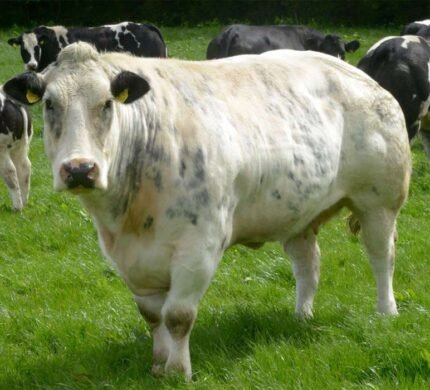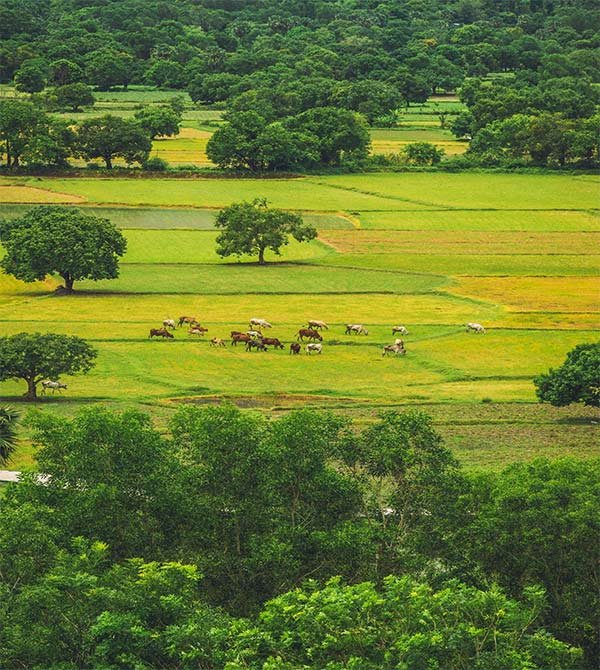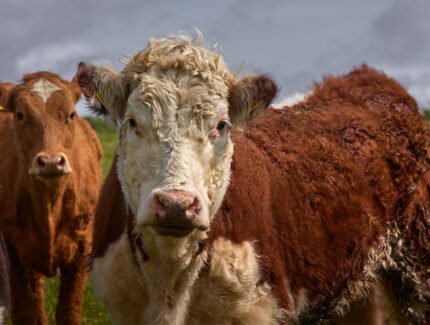Belgian Blue
- Temperature:10°C to 25°C (50°C to 77°F)
- Milk:Not raised for milk production
- Food:Beef, with lower fat and higher protein
- Pregnancy:Approximately 9 months
- Nationality:Belgium

General Information
Belgian Blue cattle, also known as “Race de la Moyenne et Haute Belgique,” are a breed of beef cattle that are renowned for their impressive muscular build.
Belgian Blues are hardy animals that are well-suited for outdoor living, although they can also be kept indoors if necessary. They have a good feed conversion rate, meaning they can convert their food into muscle mass efficiently, which makes them a popular choice for beef production.
Belgian Blue cattle are medium to large-sized animals, with mature cows typically weighing around 650-850 kg (1430-1870 lbs) and mature bulls weighing around 1000-1300 kg (2200-2860 lbs). They are typically docile and easy to handle, making them a good choice for both experienced and novice cattle farmers.
Although the breed is known for its muscular build, it is important to note that not all Belgian Blues will have the same degree of muscling, and there is a range of variation within the breed. Additionally, the muscular build of Belgian Blues can sometimes cause issues with calving, so it is important to carefully manage breeding and birthing practices to ensure the safety of both the cow and the calf.
Overall, Belgian Blue cattle are a fascinating and distinctive breed that is well-suited for beef production. Their impressive muscular build, docile temperament, and good feed conversion rate make them a popular choice for many farmers and ranchers around the world.
Where we find this cow to buy?
Belgian Blue cattle originate from Belgium. Due to a genetic mutation, they gain more muscle mass. Several ways exist to find Belgian Blue cattle:
01. Contact a breeder: Belgian Blue cattle for sale can be found at a breeder who specializes in the breed. Online searches or breed associations can help you locate Belgian Blue breeders in your area.02. Livestock Auctions: Livestock auctions can be a good place to find Belgian Blue cattle for sale. Check with your local auction house or search online for upcoming livestock auctions in your area.03. Online Marketplaces: Online marketplaces such as Craigslist, Facebook Marketplace, and livestock classifieds websites may also have listings for Belgian Blue cattle for sale.04. Breed Associations: Belgian Blue cattle are often for sale at cattle shows and exhibitions. Check with your local or regional cattle association for upcoming events.
A reputable breeder can help you learn about Belgian Blue cattle’s health, genetics, and temperament. Whether it has been bred, shown or raised for meat, it should meet your specific needs.

How to increase milk production in Belgian Blue?
Belgian Blue cattle are primarily raised for beef production, and are not typically used for commercial dairy production. However, like all cattle, Belgian Blue cows are capable of producing milk, and may be used for small-scale dairy production. If you are interested in increasing milk production in your Belgian Blue cows, here are some general tips:
Optimal milk production requires proper nutrition. High-quality feed is essential for Belgian Blue cows at all stages of their development. Consult a veterinarian or nutritionist for a feeding program.
Cows that are healthy and free from disease are more likely to produce higher quantities of milk. Develop a health program for your herd that includes regular checkups with a veterinarian.
Cows that are comfortable and stress-free are more likely to produce milk. Clean, dry, well-ventilated conditions are crucial to a healthy Belgian Blue cow, along with fresh water and adequate space.
Monitor your Belgian Blue cow’s milk production regularly to identify problems early on. Use a milking machine or hand-milking techniques that are appropriate for their comfort and wellbeing.
It is important to note that while these tips may help increase milk production in Belgian Blue cows, their milk production will likely still be lower than that of dedicated dairy breeds. Additionally, it is important to work with a veterinarian and/or a dairy specialist to ensure that your cows are receiving appropriate nutrition and that milk production is being monitored closely.
Medicine
Like all cattle, Belgian Blue cattle may require veterinary care and medicine at various times throughout their lives. It is important to work with a veterinarian to develop a herd health plan and to administer medications appropriately to ensure the health and wellbeing of your animals.
It is important to always follow the dosage instructions provided by your veterinarian, and to administer medications only to the animals for which they are prescribed. Keep accurate records of any medications administered, including the name of the medication, the dosage, and the date and time of administration. By working closely with a veterinarian and following good herd health practices, you can help ensure the health and wellbeing of your Belgian Blue cattle.
Common medications that may be used in the treatment of Belgian Blue cattle include:
01
AntibioticsA number of bacterial infections of the Belgian Blue cattle are treatable with antibiotics, including pneumonia, mastitis, and footrot, which are also caused by antibiotics.
02
Parasite ControlParasites such as internal worms and external parasites like lice and mites can be problematic for cattle. There are a variety of medications available to control these parasites.
03
VaccinationsShed health plans include vaccinations as they help prevent common diseases. Talk to your veterinarian about recommended vaccination protocols for your herd.
04
Pain ReliefBelgian Blue cattle may experience pain when injured, ill, or castrated or dehorned. Pain relief medication may be prescribed to help manage discomfort.

- Belgian Blue cattle are primarily raised for beef production, and their meat is known for its high-quality, tenderness, and marbling. Due to their muscular build, Belgian Blue beef tends to be leaner than other types of beef, with lower fat content and higher protein content.
- Belgian Blue cattle are typically fed a diet of hay, silage, and other roughage, along with grains such as corn or barley to provide energy and additional nutrients. Some farmers also supplement their diet with mineral supplements to ensure they get all the nutrients they need for healthy growth.
Important!
It is important to note that the nutritional content and quality of beef can also be affected by factors such as the animal’s age, the farming practices used, and the processing methods used after slaughter. If you are interested in trying Belgian Blue beef, it is a good idea to look for high-quality, sustainably-raised beef that has been processed in a responsible and ethical manner.
Pregnancy
Adequate nutrition is critical for the health of both the cow and her developing calf. A balanced diet is best for pregnant Belgian Blue cows. Consult with a veterinarian or nutritionist to develop a feeding plan that meets her specific needs.
Regular veterinary check-ups and preventative health measures are important during pregnancy. Work with a veterinarian to develop a herd health plan that includes vaccinations, parasite control, and any necessary treatments.
Monitor your Belgian Blue cow’s condition throughout pregnancy, and watch for signs of any problems such as loss of appetite, weight loss, or abnormal discharge. If you notice any concerning symptoms, contact your veterinarian immediately.
As your cow nears the end of her pregnancy, it is important to prepare for the upcoming calving. Make sure that you have a clean and dry calving area prepared, and that you have any necessary equipment on hand, such as obstetrical chains or a calf puller.
Facts
Aberdeen Angus is a breed of cattle that originated in Scotland, and is now one of the most popular breeds in the world. Here are some interesting facts about the breed:
The Belgian Blue breed originates from Belgium, where it was developed in the 19th century by selectively breeding cattle for meat production.
Generally speaking, Belgian Blue cattle are easy to handle and docile, making them a good choice for beef producers who require a low-maintenance breed.
In terms of size, Belgian Blue cattle are typically large, with bulls weighing up to 1,500 kg (3,300 pounds) and cows weighing up to 900 kg (2,000 pounds).
Belgian Blue cattle are known for their muscular, heavily-muscled physique, which is a result of their unique genetic makeup. They have short, smooth hair that can range in color from white to blue-grey.
Cattle of this breed are generally healthy, but they are prone to certain genetic conditions, such as double muscling. The breed’s characteristics are of the utmost importance to breeders and veterinarians.
Belgian Blue cattle are primarily raised for their meat, which is known for its tenderness and leanness. The breed’s low fat content and high muscle mass make it popular among producers of lean beef.